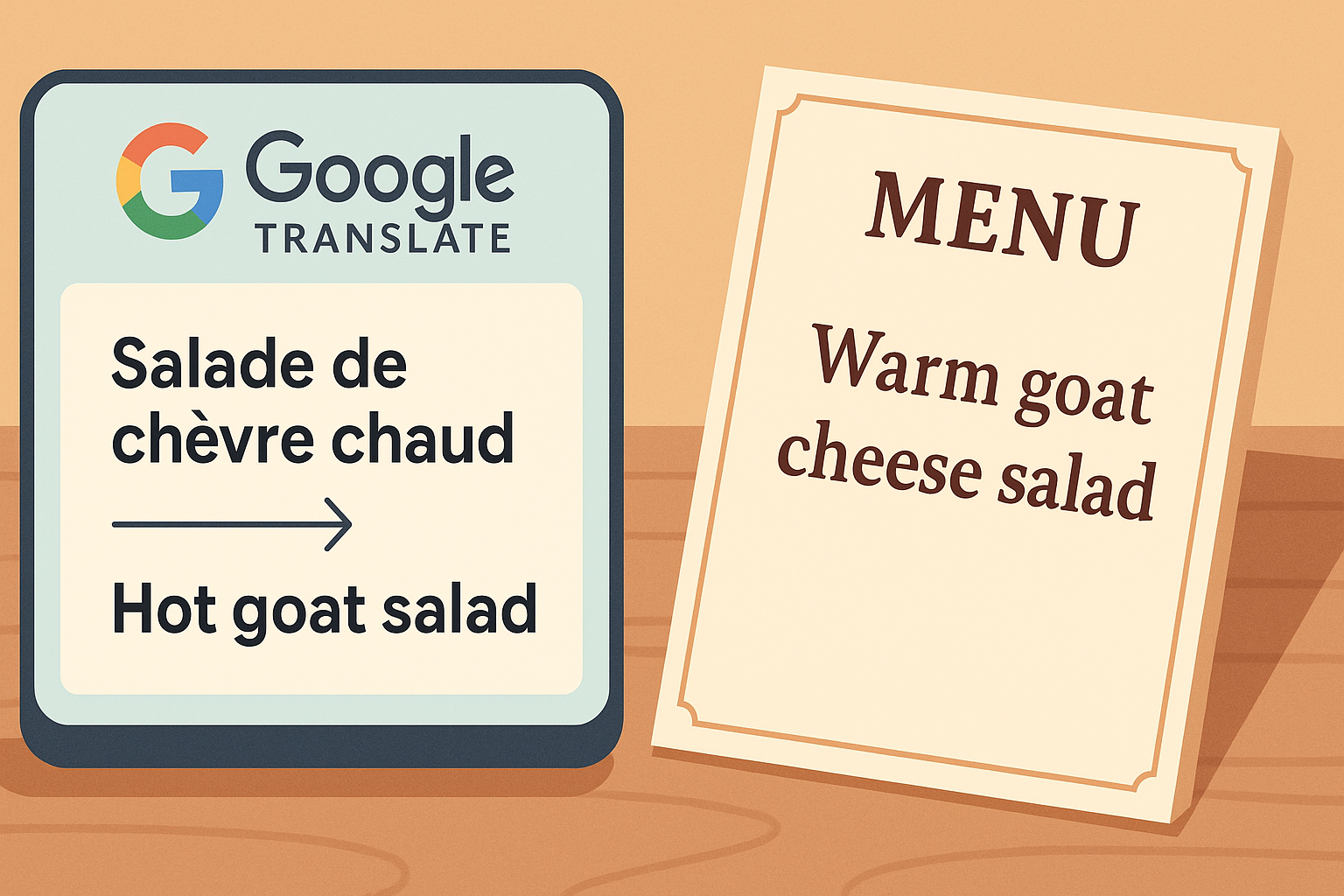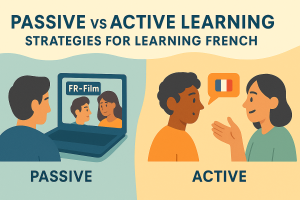Google Translate vs professional translation — real French to English fails (A2–C1)
Google Translate revolutionized accessibility to translation, but machine learning algorithms still produce embarrassing, confusing, and sometimes dangerous mistakes when translating French to English. This guide examines real translation fails, explains why they happen, reveals contexts where automated translation creates problems, and teaches you when to trust machines versus when to consult professionals or use better tools.

The promise and limitations of machine translation
Google Translate processes over one hundred billion words daily across more than one hundred languages, making it humanity’s most-used translation tool. Neural machine translation (NMT) algorithms improved accuracy dramatically since 2016, moving from word-by-word translation to context-aware phrase translation. For simple texts with straightforward vocabulary, modern Google Translate often produces serviceable results that convey basic meaning.
However, translation requires more than pattern matching in training data. Human translators understand cultural context, recognize idiomatic expressions, grasp subtle connotations, adapt register appropriately, and make judgment calls about ambiguous passages. Google Translate lacks this deeper comprehension, instead relying on statistical probability from its training corpus. When encountering situations outside common patterns, the system produces errors ranging from amusing to catastrophic.
Understanding where and why Google Translate fails helps you use it intelligently during your French learning journey—leveraging its strengths for quick comprehension while avoiding dangerous over-reliance on machine translation for critical contexts. Professional translators view Google Translate as a first-draft tool requiring human verification, never as a final translation source.
False friends — when similarity deceives
Classic False Friend Fail: “Actuellement”
French original: “Je travaille actuellement sur ce projet.”
Google Translate (WRONG): “I am actually working on this project.”
Correct translation: “I am currently working on this project.”
Why it fails: Google Translate often correctly translates “actuellement” as “currently,” but in certain sentence structures or contexts, it defaults to the false cognate “actually,” completely changing the meaning. The French “actuellement” means “currently/presently” while English “actually” means “in fact/really.”
Dangerous Medical Mistake: “Blessé”
French original: “Il a été blessé dans l’accident.”
Google Translate (WRONG): “He was blessed in the accident.”
Correct translation: “He was injured in the accident.”
Why it fails: “Blessé” looks like “blessed” but means “injured/wounded.” This confusion could have serious consequences in medical contexts where accurate communication saves lives. Google Translate occasionally makes this error depending on surrounding context.
⚠️ Critical warning: Never use Google Translate for medical, legal, or safety-critical documents. The cost of mistranslation in these contexts far exceeds professional translation fees. Lives and legal outcomes depend on accuracy.
French and English share thousands of false friends through their common Latin heritage and Norman conquest influence. While Google Translate’s training data helps it avoid the most common false friends most of the time, edge cases and unusual contexts still trigger errors. The system cannot “understand” that “demander” means “to ask” not “to demand,” or that “location” means “rental” not “location”—it only knows statistical patterns from training data.
Idiomatic expressions — lost in literal translation
Idiom Disaster: “Avoir le cafard”
French original: “J’ai le cafard aujourd’hui.”
Google Translate (WRONG): “I have the cockroach today.”
Correct translation: “I’m feeling down/depressed today.”
Why it fails: This idiomatic expression literally references a cockroach but figuratively means feeling melancholy or depressed. Google Translate translates the words without recognizing the idiomatic meaning, producing nonsensical English.
Body Part Confusion: “Coûter les yeux de la tête”
French original: “Cette voiture coûte les yeux de la tête.”
Google Translate (WRONG): “This car costs the eyes of the head.”
Correct translation: “This car costs an arm and a leg.” (or “This car is extremely expensive.”)
Why it fails: Each language has unique body-part idioms for expressing cost. Google Translate provides literal translation without recognizing the English equivalent idiomatic expression. The literal translation sounds bizarre rather than conveying expense.
Weather Idiom Fail: “Il pleut des cordes”
French original: “Il pleut des cordes dehors.”
Google Translate (WRONG): “It’s raining ropes outside.”
Correct translation: “It’s raining cats and dogs outside.” (or “It’s pouring rain outside.”)
Why it fails: French uses “ropes” where English uses “cats and dogs” to describe heavy rain. Machine translation cannot make this cultural-linguistic leap without explicitly programmed idiom databases, which inevitably remain incomplete.
Idiomatic expressions pose the greatest challenge for machine translation because they require cultural knowledge and figurative thinking that pattern-matching algorithms cannot replicate. While Google Translate’s database includes many common idioms, regional variations, new expressions, and context-dependent usage frequently trigger literal translation errors that native speakers immediately recognize as awkward or incomprehensible.
Context and ambiguity failures
Polysemy Problem: “Avocat”
French original: “J’ai rendez-vous avec mon avocat à midi.”
Google Translate (WRONG in some contexts): “I have an appointment with my avocado at noon.”
Correct translation: “I have an appointment with my lawyer at noon.”
Why it fails: “Avocat” means both “lawyer” and “avocado” in French. While context usually clarifies which meaning applies, Google Translate sometimes chooses incorrectly, especially in shorter sentences or ambiguous contexts. The algorithm relies on surrounding words to determine meaning, but insufficient context produces absurd results.
Pronoun Confusion: Gender and “Il/Elle”
French original: “Le médecin est arrivé. Elle a examiné le patient.”
Google Translate (WRONG): “The doctor arrived. He examined the patient.”
Correct translation: “The doctor arrived. She examined the patient.”
Why it fails: French gendered pronouns (il/elle) don’t always align with English assumptions. Google Translate sometimes defaults to gender stereotypes (doctor = he) rather than tracking pronoun reference correctly across sentences. This reflects both algorithmic limitations and bias in training data.
Register Mismatch: Formal vs Informal
French original: “Je vous prie d’agréer, Madame, mes salutations distinguées.”
Google Translate (WRONG): “Please accept, Madam, my distinguished greetings.”
Correct translation: “Yours sincerely,” or “Respectfully yours,”
Why it fails: French business email closings use elaborate formulas without direct English equivalents. Literal translation produces awkward, overly formal English that sounds archaic or pretentious. Professional translators adapt register and cultural conventions rather than translating word-for-word.
Context determines meaning in natural language, but machines struggle with contextual inference that humans perform unconsciously. Ambiguous pronouns, words with multiple meanings, cultural references, and register conventions all require understanding beyond pattern matching. Google Translate improves with longer input text providing more context, but short phrases and isolated sentences often produce errors.
Grammar and structure mistakes
Negation Confusion: “Ne…que”
French original: “Je ne bois que de l’eau.”
Google Translate (WRONG sometimes): “I don’t drink only water.”
Correct translation: “I only drink water.”
Why it fails: The French construction “ne…que” means “only” but structurally resembles negation. Google Translate sometimes interprets this as double negative rather than restrictive meaning, producing grammatically incorrect or confusing English.
Subjunctive Mood Errors
French original: “Il faut que tu viennes immédiatement.”
Google Translate (acceptable but unnatural): “It is necessary that you come immediately.”
Better translation: “You need to come immediately.” or “You must come immediately.”
Why it’s problematic: While technically accurate, Google Translate often produces overly literal translations of subjunctive constructions that sound stiff in English. Natural English prefers simpler structures where French uses subjunctive mood.
Grammatical structures don’t map one-to-one across languages. French uses subjunctive mood extensively where English prefers infinitives or modal verbs. French negation patterns differ from English. Word order, article usage, and verb tenses all require structural adaptation rather than direct substitution. Machine translation improves but still produces grammatically awkward constructions that reveal their automated origin.
When Google Translate works acceptably
Simple, factual texts
Google Translate handles straightforward factual information reasonably well: product descriptions, basic news articles, simple instructions, and informational texts with concrete vocabulary and standard sentence structures. When texts avoid idioms, cultural references, and complex grammatical constructions, machine translation produces comprehensible results suitable for understanding general meaning.
Getting the gist of informal communication
For understanding casual emails from friends, social media posts, or informal messages, Google Translate provides enough comprehension to grasp main ideas even when details contain errors. In low-stakes contexts where perfect accuracy isn’t critical, machine translation serves as a useful quick-comprehension tool.
💡 Smart usage tip: Use Google Translate for first-pass comprehension of informal texts, then verify important details with better dictionary resources like Linguee or WordReference for critical words or phrases.
Learning vocabulary in context
For language learners encountering new words while reading, Google Translate provides quick context-aware definitions more convenient than traditional dictionary lookup. While not perfect, this usage helps maintain reading flow while building vocabulary. Always verify critical vocabulary with authoritative sources, but for casual learning, Google Translate accelerates comprehension.
When you absolutely need professional translation
Legal documents
Contracts, court documents, immigration papers, and legal correspondence require certified professional translation. Mistranslations have serious legal consequences including invalid contracts, denied visa applications, or lost court cases. The cost of professional legal translation represents insurance against catastrophic errors.
Medical and healthcare contexts
Patient histories, medication instructions, medical diagnoses, and healthcare communications demand accuracy where mistakes endanger lives. Professional medical translators understand specialized terminology and recognize critical distinctions that machine translation misses. Never rely on Google Translate for medical documents.
Business and marketing materials
Professional documents representing your business—websites, marketing materials, business communications, presentations—require human translation to maintain brand voice, adapt cultural references appropriately, and avoid embarrassing mistakes that damage credibility. Machine translation errors in public-facing content harm professional reputation.
Academic and technical documents
Research papers, technical manuals, academic theses, and specialized publications require translators with subject matter expertise who understand field-specific terminology and conventions. Google Translate lacks the specialized knowledge necessary for accurate technical translation.
How to use Google Translate intelligently
Strategy 1: Translate both directions for verification
After translating French to English, paste the English result back into Google Translate to retranslate to French. If the retranslation differs significantly from your original French, the initial translation likely contains errors. This back-translation technique reveals major mistakes without requiring bilingual proficiency.
Strategy 2: Provide maximum context
Google Translate performs better with complete sentences and paragraphs than isolated phrases. Include full context around the text you need translated—surrounding sentences, document titles, subject headers. More contextual information helps the algorithm select appropriate word meanings and grammatical structures.
Strategy 3: Simplify input before translating
Complex French sentence structures with multiple clauses, nested subordination, or elaborate constructions confuse machine translation. Before translating, simplify French text into shorter sentences with straightforward grammar. This pre-editing improves output quality significantly.
Strategy 4: Cross-reference with better tools
Never trust Google Translate alone. Use it for quick comprehension, then verify important words and phrases with Linguee for contextual examples, check idioms in specialized resources, and consult authoritative dictionaries like CNRTL for nuanced understanding. Multi-tool verification catches errors single-source reliance misses.
💡 Professional tip: For important translations, use Google Translate as a rough draft, then have a bilingual friend or professional translator review and refine the output. This hybrid approach combines machine efficiency with human accuracy.
Strategy 5: Learn to recognize common error patterns
Familiarize yourself with typical Google Translate mistakes—false friends, literal idiom translations, gender pronoun errors, register mismatches. When you know what to watch for, you can catch and correct errors before they cause problems. This meta-knowledge about machine translation limitations makes you a smarter user.
The future of machine translation
Neural machine translation continues improving through larger training datasets, more sophisticated algorithms, and specialized models for particular language pairs and domains. Google Translate will get better at handling idioms, context, and cultural adaptation. However, fundamental limitations remain: machines cannot truly “understand” meaning, cultural nuance, or communicative intent the way humans do.
Large language models like ChatGPT and Claude show promise for better contextual translation by leveraging broader knowledge and reasoning capabilities beyond pattern matching. These tools can explain why particular translations work, adapt register more appropriately, and handle ambiguity more intelligently. The future likely involves hybrid approaches combining machine efficiency with human oversight and judgment.
For language learners, improving your own French proficiency remains more valuable than relying on better translation tools. Understanding French directly eliminates translation as an intermediary step, providing deeper comprehension and more authentic communication than any machine or human translator can facilitate.
Study glossary — translation terminology
| EN | FR | Definition |
|---|---|---|
| Machine translation | Traduction automatique | Automated translation by computer algorithms |
| False friend | Faux ami | Words that look similar but have different meanings |
| Idiomatic expression | Expression idiomatique | Phrase with figurative meaning beyond literal words |
| Context | Contexte | Surrounding information that clarifies meaning |
| Register | Registre | Degree of formality in language use |
| Ambiguity | Ambiguïté | Unclear meaning with multiple interpretations |
| Literal translation | Traduction littérale | Word-for-word translation without adaptation |
| Professional translator | Traducteur professionnel | Human expert trained in translation |
| Source language | Langue source | Original language being translated from |
| Target language | Langue cible | Language being translated into |
| Back-translation | Rétro-traduction | Translating back to verify accuracy |
| Nuance | Nuance | Subtle shade of meaning or expression |
Authoritative references
- Linguee — better contextual translation than Google Translate.
- DeepL — more accurate machine translation alternative.
- American Translators Association — find certified professional translators.
Learn French with Roger, Native French Tutor
Expert instruction with proven teaching methods. Personalized lessons tailored to your goals from A0 to C1.
Weekly Lessons with Roger
Learn with Roger, a native French tutor. Structured curriculum from beginner to advanced.
- Native French speaker from France
- All levels (A0-C1) supported
- Personalized curriculum
- Proven teaching methodology
Trial Lesson with Roger
Experience Roger’s teaching method with a 25-minute trial session. Perfect to get started.
- 25 minutes with Roger
- Level assessment included
- Personalized learning roadmap
- No commitment required
A1 Foundations Guide
Complete beginner’s guide created by Roger. Structured lessons with native pronunciation.
- Step-by-step A1 curriculum
- Audio by native French speaker
- Practice exercises included
- Learn at your own pace
Continue Learning
Check out these related articles

How to order drinks in French bars — regional alcohols and essential phrases (A2–B2)
Master ordering drinks in French bars and cafés with essential phrases, understand French bar etiquette, and discover regional alcoholic beverages…

French restaurant booking phrases (A0–A2) — reserve, arrive, order
french restaurant booking phrases help you secure a table, arrive smoothly, and start the meal with confidence. This A0–A2 guide…

How long does it really take to learn French? — realistic timeline for English speakers (A1–B2)
Discover realistic timelines for learning French as an English speaker, from beginner to fluent, with CEFR milestones, study hour estimates,…
👋 Join Our Community
Follow us for daily tips, pronunciation tricks, and free resources
👍 Follow on Facebook